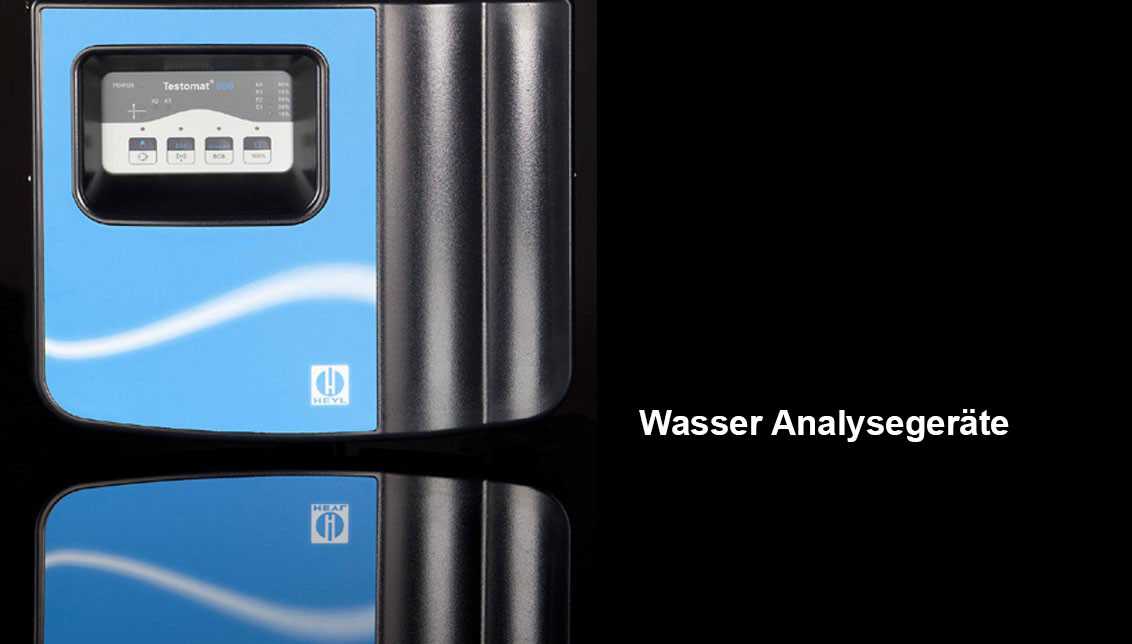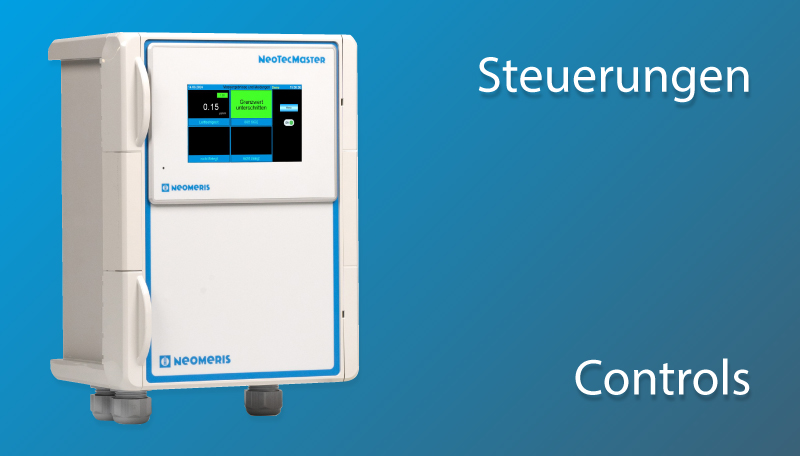€19,971.65*
Please log in to receive your conditions.
Available in 49 days, delivery time 1-2 days
(Login for quotation) The entered number of pieces will be taken into account when creating the offer.
Product information "NeoPermIon permeate cabinet system – 230 l/h incl. Aqua-Stop, sensor and drip trays"
For applications that do not require deionised water, we offer a modified version of our cabinet system that is capable of producing permeate. Unlike the deionised water treatment system, the permeate cabinet system consists of only one cabinet. Water treatment involves pre-filtration, a softening system, a reverse osmosis system with a 100-litre permeate tank including a water seal and sterile filter, and a pressure booster station. If required, a brine lifting system can also be integrated into the first cabinet. The installed components are listed again below:
- Cabinet
- Filter system (pre-filter & activated carbon filter)
- Water softener
- Reverse osmosis system
- Permeate tank 100 litres (volume can be adjusted)
- Pressure booster station
- Brine lifting system (optional)
System performance:
Depending on the system design, 90 l, 150 l, 230 l or 300 l of permeate can be produced per hour.
The capacity of the permeate tank is adjustable, but may need to be positioned outside the cabinet due to its larger dimensions.
Shut-off via system separator
To protect the drinking water network from contamination by treated water or changes in the natural composition of the drinking water fed into the system as a result of technical treatment, the installation of a system separator is mandatory. The system has an integrated system separator (type BA), which is located directly behind the Aqua-Stop of the water connection.
Aqua-Stop (solenoid valve shut-off)
An Aqua-Stop is a safety mechanism used in water supply systems to stop or limit the flow of water in the event of a malfunction or leak. It is usually an automatic shut-off mechanism that closes the water supply valve to prevent major water damage.
A solenoid valve is a type of shut-off valve that is controlled by the use of an electromagnetic field. In water treatment, a solenoid valve is used to shut off or regulate the flow of water. The solenoid valve consists of an electromagnetic coil system and a valve mechanism. Applying an electrical voltage to the coil generates a magnetic field that influences the valve mechanism. Depending on the application, the solenoid valve can be opened or closed to allow or block the flow of water. In combination, additional safety and control over the water flow can be ensured.
The Aqua-Stop is located directly behind the main water connection of the system as the first element. The associated solenoid valve is coupled with two sensors, one of which continuously monitors the base trays of the two cabinet systems.
Filter system
The pre-filter section is a filter unit consisting of a pre-filter and an activated carbon filter. Its main purpose is to protect downstream softening and osmosis systems, which could be damaged by impurities in the water.
Water softener
A water softener is used to remove excess minerals, especially calcium and magnesium ions, which are responsible for the hardness of the water. It works on the basis of an ion exchange process.
Reverse osmosis
Reverse osmosis reverses the natural osmotic process. In this process, the softened water is forced through a membrane under pressure, whereby the membrane only allows water molecules and very small molecules to pass through and retains larger particles such as salts, bacteria, viruses and other impurities.
Permeate tank
A round tank offers advantages in terms of stability, cleaning, energy efficiency and space utilisation, making it the preferred choice for storing and treating water in treatment plants. Its uniform shape and flow characteristics ensure that the water is treated and stored efficiently.
Pressure boosting station
A pressure boosting station is used to continuously supply the connected consumers with the required operating pressure.
Cabinet systems
Only a minimum floor space of 0.80 m x 1.40 m is required to install this module from HeylNeomeris. The module consists of a cabinet that is 0.80 m wide and 0.60 m deep. It is possible to use double doors, which, due to the depth of 60 cm and a double door with a dimension of 40 cm, results in a minimum room depth of 1 m.
The cabinets used are made of sturdy sheet steel modules and have a high-quality surface coating.
Wastewater disposal via brine lifting unit (optional)
As an optional component, the treatment plant can be expanded to include an integrated wastewater lifting unit, which transports the generated and collected wastewater into the sewer system. The main wastewater flows here are the wastewater from the regeneration of the softening plant and the concentrate from the reverse osmosis process.
Collection tray
The integrated collection tray in the cabinet serves to collect potential leaks or escaping liquids that could escape from the pipes or components. This is particularly important, for example, in industrial applications or in environments where sensitive electronic equipment or chemicals are stored.
Dimensions
| Height | 190 cm |
|---|---|
| Length | 60 cm |
| Width | 80 cm |
Weight
| Weight | 224 kg |
|---|
Other attributes
Permeate - the most important areas of application
In water treatment, permeate refers to the filtered or purified water that has passed through a membrane. It is the “end product” of processes such as reverse osmosis, nanofiltration or ultrafiltration.
Permeate is free of larger particles, dissolved salts, microorganisms or other impurities (depending on the filter type). The opposite of permeate is the concentrate (or retentate): the retained, “depleted” water with the separated substances.
Typical areas of application in which permeate water is required are drinking water treatment, industrial processes (e.g. for boiler feed water), the food industry and pharmaceutical production.
Permeate is therefore required in many areas where high-purity or specifically treated water is required.
The areas of application for permeate are described below:
- Drinking water treatment
- Removal of salts, germs, heavy metals or pollutants
- Use in seawater desalination or well water treatment
- food and beverage industry
- Production of beverages (e.g. table water)
- Milk processing (e.g. for lactose or protein fractionation)
- Pharmaceutical industry
- Production of ultrapure water for medicines or infusion solutions
- Use in cleaning processes (CIP/SIP)
- electronics and semiconductor industry
- Production of ultrapure water for wafer cleaning and production
- Power plants and industrial facilities
- Feed water for steam generators and boiler systems
- Corrosion protection and reduction of deposits
- Aquaristics and laboratory technology
- Pure water for sensitive organisms or analytical processes
But what is the difference between permeate and demineralized water?
The difference between permeate and demineralized water (fully demineralized water) lies in the purity and the type of treatment:
Permeate
- Origin: Result of membrane filtration (e.g. reverse osmosis)
- Purity: Highly reduced in salts and organic compounds, but usually not 100% salt-free
- Conductivity: Typically 10-50 µS/cm (depending on precursor and quality)
- Use: Pre-treatment for demineralized water, process water, drinking water treatment
Demineralized water (fully demineralized water)
- Origin: Treatment using ion exchangers, often downstream of reverse osmosis
- Purity: Almost completely salt-free
- Conductivity: < 1 µS/cm (often even < 0.1 µS/cm)
- Application: Boiler feed water, pharmaceuticals, electronics, laboratory
Permeate can therefore no longer be used if it no longer meets the quality requirements of the respective area of application. Typical reasons why permeate becomes unsuitable are
- too high conductivity
- Indication of increased salt content or leaks in the membrane
- Critical e.g. in semiconductor, pharmaceutical or steam production
- Microbiological contamination
- Biofilm formation in pipes or tank systems
- Problematic in hygienically sensitive processes (pharmaceuticals, food)
- Organic or chemical contamination
- Redissolution due to poor materials or chemical reactions
- Limit of use reached in laboratory, analysis or medical technology
- Membrane ageing or defect
- Decreasing retention rate → permeate becomes too “permeable”
- Typical with old or improperly operated systems
- Demineralized water or ultrapure water requirements
- Permeate is not sufficient for processes that require fully demineralized or ultra-pure water
In such cases, the permeate is discarded if it cannot be post-treated or is post-treated (e.g. with mixed-bed ion exchangers, UV, final filtration). The post-treated permeate then becomes demineralized water.
The table below shows a comparison of permeate and demineralized water (fully demineralized water):
|
Criterion |
Permeate |
Demineralized water |
|
Production process |
Membrane process (e.g. reverse osmosis) |
Ion exchange (anion & cation exchangers) |
|
Salt content |
Highly reduced, but not completely removed |
Almost completely salt-free |
|
Conductivity |
approx. 5-50 µS/cm |
< 1 µS/cm (usually < 0.2 µS/cm) |
|
Areas of application |
Process water, precursor to demineralized water |
Boiler feed water, pharmaceuticals, electronics |
|
Costs |
Lower with the same quantity |
Higher due to resin consumption and regeneration |
|
Regeneration necessary? |
No |
Yes (regular regeneration with chemicals) |
|
Use of chemicals |
Low |
High (e.g. acids and alkalis) |
|
Sustainability |
Higher (less chemicals, less waste water) |
Low (chemicals, residues) |
|
Typical place of use |
General industry, food, pre-treatment |
Ultrapure water systems, sensitive processes |
Permeate is therefore the central product of membrane filtration - i.e. the purified water that fulfills essential quality requirements for many applications. Here is a summary of the main reasons for its importance:
- Aim of water treatment
- The main aim of many treatment processes is to produce permeate of a defined quality.
- It forms the basis for downstream processes or direct consumption (e.g. drinking water, process water).
- High purity - but cost-efficient
- Permeate contains significantly fewer dissolved substances, germs and organic contamination.
- It can be produced at a lower energy cost than fully demineralized water with chemical regeneration.
- Flexible in use
- Permeate can be used directly or processed further (e.g. into demineralized water).
- Ideal as base water for many industries: Food, chemicals, pharmaceuticals, energy.
- Conserves resources
- Reverse osmosis and related processes reduce chemical consumption (e.g. no regeneration agents as with ion exchangers).
- Enables sustainable concepts such as recirculation and water recycling.
- quality can be controlled
- The quality of permeate can be easily monitored via conductivity, TOC or bacterial counts.
- Quick intervention possible in the event of process deviations.
Together, we are responsible for the responsible use of the resources required for the process. The water used in the water treatment process is one of the scarcest resources available to us.
By recovering and reusing water, Permeat makes a significant contribution to conserving natural resources and reducing environmental pollution.
For this reason, the conservation of resources through the use of permeate is examined in detail below.
- Reuse of water: Permeate is the purified water that remains after a filtration process (e.g. reverse osmosis). It can be reused - e.g. for technical processes, cooling or even drinking water - which means less fresh water is required.
- Reduction of waste water: By recovering water as permeate, less waste water is produced, which is good for the environment and reduces disposal costs.
- Energy efficiency: Modern membrane processes for permeate production are often more energy efficient than other treatment processes, which reduces the consumption of energy resources.
- Sustainable use of raw materials: The use of permeate helps to use natural water resources more sparingly and in a more targeted manner.
In conclusion, it can be said that permeate is a key component of innovative membrane processes in water treatment and makes a significant contribution to increasing efficiency and conserving resources.
Permeate helps to treat water in a modern and environmentally friendly way - an important step towards a sustainable future.






